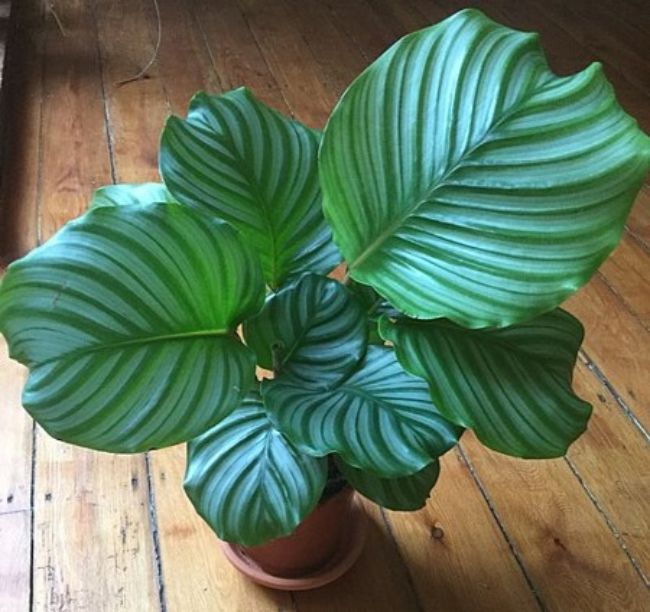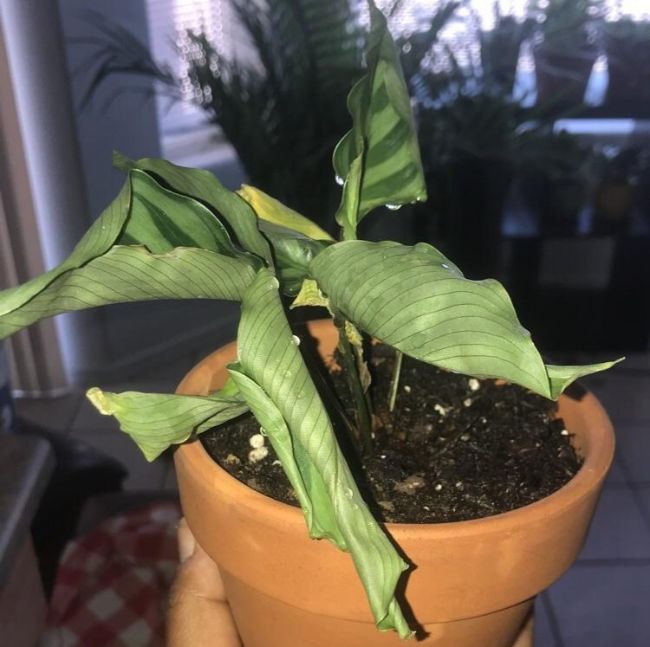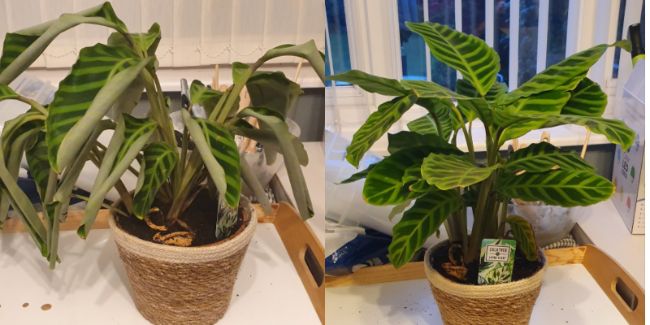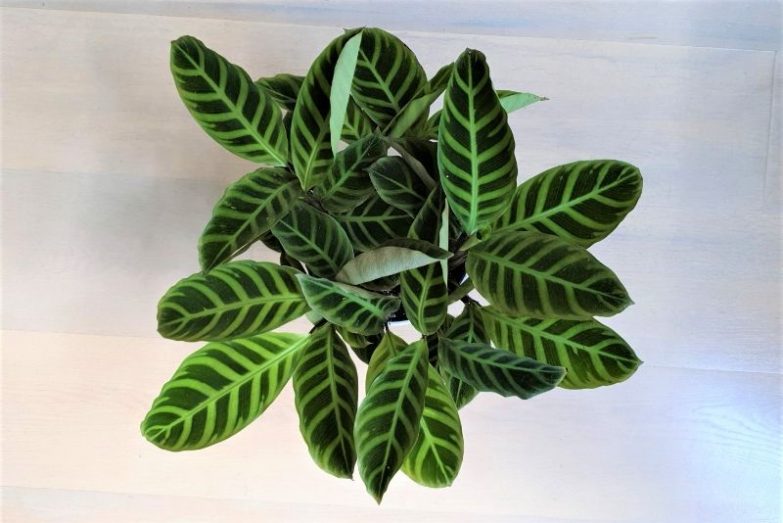Calatheas are temperamental and expressive plants that like to provide plenty of visual cues when they are not happy. Calathea leaves curling is a sign that something is wrong with your plant. If you can identify the problem and get your calathea to relax, the leaves will unfurl, and your plant will return to its normal, healthy appearance.
Calathea leaves curling is a sign of plant dehydration and is a mechanism the plant uses to reduce water loss. Leaf curling is most commonly due to underwatering, low humidity, or excess heat, but can also happen due to root damage caused by root rot, overfertilizing, or disease.
Calatheas might be finicky plants, but they respond extremely quickly when they’re given the right kind of care. Try these tips to get your Calathea thriving again in no time.
How To Unfurl Your Calathea’s Leaves
Calathea plants like to move their leaves. A healthy Calathea will slowly turn its leaves to catch ambient rays of sunshine; an unhealthy Calathea will curl its leaves tightly to signify distress. Once you fix the problem, the leaves might even uncurl before your eyes.
- Move your plant out of the light. Calatheas hate direct sunlight; too much exposure will permanently damage their leaves. Move them away from the window, but make sure that there is still ambient light for them to absorb.
- Adjust the temperature in the room. Calatheas do best in temperatures between 60-85°F (16-29°C). Don’t just check the room temperature – check the temperature in the place where your Calathea sits.
- Add humidity to the environment. A lack of humidity is the most common reason Calathea leaves curl. Read my article on increasing humidity, and monitor humidity levels with a digital hygrometer (I couldn’t do without one of these).
- Change your watering habits. Your Calathea’s soil should stay moist at all times, but it should never sit in standing water. Monitor your watering habits closely to develop the perfect balance.
- Switch to distilled water. Hard water that’s full of salt or other minerals is toxic to your Calathea. Consider using bottled water or rainwater for a healthier plant.
Once you’ve gone through these steps, you should notice that your Calathea is bright, relaxed, and looking much healthier. Gently prune away any leaves that are permanently damaged. Give your Calathea at least a week to respond to the new conditions, and watch the plant carefully to avoid future problems.
Let’s go on to look at the five reasons why Calathea leaves curl in a little more detail.

1. Too Much Light Causes Calathea Leaves To Curl
Wild Calathea plants grow beneath the canopies of tropical rainforests. These plants thrive in shady, low-light conditions that mimic the cool undergrowth of their traditional home.
Direct sunlight will fade the leaves of your Calathea plant and may even remove the beautiful white and green markings. Calatheas often curl their leaves in an attempt to reduce the amount of light exposure. If you move your plant back into the shade, the leaves should unfurl within a day or two.
Never place your Calathea in a sunny window or under an open light source. Instead, find a shady spot with a moderate amount of ambient room light. Caletheas love access to indirect sunlight; if you place them near a north-facing window, you might even notice the leaves moving to catch a little extra sunshine.
Wherever you place your Calathea, make sure that direct sunlight doesn’t hit the plant at any point in the day. You may want to place a small obstruction between your plant and the light to avoid scorching its leaves.
2. Calathea Leaf Curling Can Be Due to Temperature Extremes
Calathea plants like to grow in temperatures that mimic their native environment. If your plant gets too cold, it will curl up in an attempt to keep itself warm. If it gets too hot, the leaves will start to dry up and shrivel. Both problems can be corrected by adjusting the temperature in the plant’s environment.
The best temperature for a Calathea plant is between 60-85°F (16-29°C). If your room is between these temperatures and the leaves are curling, try adjusting the thermostat towards the 75°F (24°C) mark. Watch how your plant reacts over a few days, and keep adjusting the temperature until the curling Calathea leaves start to resolve.
Make sure that your Calathea isn’t placed directly in front of an air conditioner or a heating vent. Blasts of hot or cold air will shock your plant and damage the leaves. Hold your hand out in front of your plant; if you can feel a wave of air, it might be too much for your delicate Calathea. Ovens, desktop computers, and other nearby heat sources might also impact the temperature of your plant.
The average room temperature on your thermostat doesn’t always reflect the actual temperature in the corner where your Calathea is sitting. This is especially true in large offices where the temperature of the entire building is taken into consideration. You can use a thermometer to check the temperature of your Calathea’s soil and surrounding environment.

3. Low Humidity Is A Very Common Cause Of Calathea Leaf Curling
Humidity is essential for a healthy Calathea. These plants absorb moisture through their wide leaves; if the air dries up, the leaves will start to curl and yellow. You may also notice a rough or brittle texture, and the edges of the leaves might break when touched.
First, give your Calathea an immediate burst of moisture by misting its leaves. Use a spray bottle on its lightest setting – direct streams of water might damage the plant, especially if its leaves are in a delicate condition.
Misting will provide moisture for two to four hours. This is not a long-term solution, but regular misting can help revive a calathea while you correct the humidity in its environment.
Next, look for a way to keep the air around your calathea as humid as possible. Humidifiers are a great solution; for small plants, look for a desktop humidifier that you can place next to them. Turn the humidifier on and off as needed to create the perfect environment.
This is the humidifier I use for my houseplants (link to Amazon) and I would hugely recommend it. It has a large reservoir, so it doesn’t need refilling too often, and makes maintaining higher humidity levels so easy.
Many Calathea owners place their plant on a bed of pebbles or peat moss submerged in water. The water will evaporate throughout the day, creating a humid environment. As long as the pool of water is not directly touching the roots of the plant, this method usually provides enough ambient moisture to keep your plant healthy. Make sure that the water is kept clean to prevent the growth of bacteria.
Finally, Calatheas and other prayer plants do exceptionally well in terrariums, bottle gardens, and other sealed environments. You can mimic this effect in the short term by placing a plastic bag over your Calathea to collect the surrounding moisture. Watch the development of condensation, and air out the bag at least once a day.
Check out my article on increasing humidity for indoor plants for more ways to keep your Calathea healthy. Remember that humid environments come with their own risks for houseplants; keep the area well-ventilated to prevent the development of mold or other problems.
4. Calathea Leaves Curling Can Be Due To Incorrect Watering
Like all houseplants, Calatheas need a very specific amount of water to stay healthy. Too little water will cause the leaves to dry out and curl up. Too much water will “drown” the plant, causing root rot, resulting in curled Calathea leaves and a very unhappy plant.
Your Calathea’s soil should feel damp but not soggy. Check the moisture levels at least once a day using a stick or your fingertip. The top of the soil should be allowed to dry slightly between waterings, but you should always be able to find moisture a few centimeters beneath the surface. Unless you’re trying to clear up a fungal problem, never let your Calathea dry out completely.
Although your Calathea needs to stay moist, it should also never be allowed to sit in a pool of water. To find the right balance, give small amounts of water on a regular basis. Make sure the water is room temperature to avoid shocking the plant. Consider how quickly water evaporates in your environment, and check on your plant at least twice a day.
To prevent root rot, make sure that your Calathea’s pot drains properly. Standing water at the base of the pot is a primary cause of plant disease.
Calatheas should be watered slightly less in the winter months. The cold air causes the plant to go slightly dormant, resulting in a lower intake of water and nutrients. Keep an eye on the soil moisture, and make sure to maintain humidity in the surrounding environment.
Read my article about how to water your houseplants perfectly every time.

5. The Type Or Quality Of Water You Use May Cause Leaf Curling
Calathea leaves curl up as a sign of distress, but the problem might not be immediately easy to identify. One common cause of sick Calatheas is an overabundance of minerals in the water source.
Tap water often has a high level of salt that will cause your Calathea to wilt and fade. If your Calathea is suffering from a hard water problem, you’ll notice that the leaves have yellow edges, and you might even see a buildup of salt on the surface of the soil.
Try switching your plant to distilled or bottled water. Depending on where you live, you can also collect rainwater to use on your plants. Leave the water out at room temperature, and remember not to give your plant too much at once.
Last Word
I hope this guide has helped you find the cause of your Calathea’s curling leaves. Calathea plants curl their leaves whenever something goes wrong, but they also revive quickly once the problem is fixed.
I have written extensively about Calatheas on this website. If you’d like to learn more, have a look at the following articles for more tips and general Calathea care advice.
- 12 stunning Calatheas you will love
- How to prevent and fix yellow leaves on Calatheas
- Peacock plant care – How to care for Calathea makoyana
- How to care for Calathea orbifolia
- How to care for Calathea zebrina
- How to care for Calathea warscewiczii (Calathea Jungle Velvet)
- How to propagate Calatheas
- How to care for Calathea roseopicta

